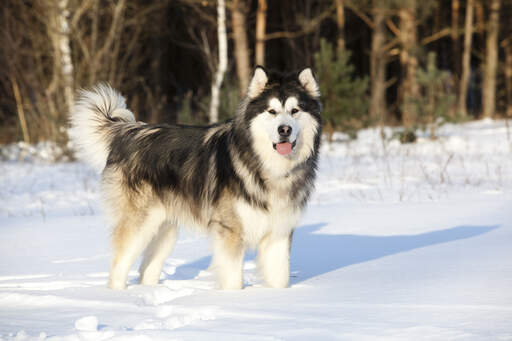Alaskan Malamute Dogs










Breed Rating (3 Reviews)
| Appearance | |
| Friendliness | |
| Hardiness | |
| Garden |
History
The Alaskan Malamute was developed in prehistory in the Arctic regions and was first discovered living among native Inuits on Alaska's north coast. The exact origin is lost in the mists of time. The dogs were bred as working animals, strong enough to pull large prey such as seals and bears back to a village. They are still a large, strong breed, adapted to colder climates. With their super-thick fur and large feet, they are adapted for pulling loaded carts or sleds through snow. They are renowned for their incredible stamina, and have a highly developed sense of smell. Malamutes are still used today to pull sleds in remote Alaskan and other North American locations, and are bred for sled racing competitions across the world.
Behaviour
Malamutes are strong and independent. They require firm training from an early age. Although they learn quickly, they remain strong-willed, which can be a problem if confined to a suburban-type house. Their size and power can cause problems, especially in an untrained dog - they can easily knock over furniture and children when excited! None of which is done out of aggression - they are a powerful, fun loving breed, and love being around people. The important point is that they need lots of exercise to eat into those high energy levels.
Malamutes love to run and have fantastic stamina, but recall can be a problem. This isn't because they don't understand the recall command, but is simply because they don't want to come back, once they focus on running. They are not good guard dogs, as they seem to love all human contact, regardless of the intentions of the human in question. They reserve their special affections for their own human 'pack' at home, though, and love being made a fuss of.
If they have not been socialized and properly trained, male Malamutes can be aggressive towards other dogs. They tend to pull on a leash too - not surprising when you consider that they were bred for pulling, hauling, and more pulling. This means that lots of leash training is needed to make them manageable when out on a walk. Luckily, they are very food-motivated, and this can help when training them. However, that tendency also makes them notorious for stealing the contents of the kitchen garbage!
A bored Alaskan Malamute can quickly become destructive, and a big breed like this can make short work of an unsuspecting chair, toy or laundry basket. They need plenty of fresh air and exercise to lose all this energy. One issue when exercising them, however, is their thick fur. Bred for cold climates, they can overheat, so you have to avoid walking them when it's too hot, and to make sure they have somewhere cool to escape the sun.
Malamutes need brushing a few times a week, and their coats shed a lot of fur. They are generally healthy, but like many breeds are prone to Chronic Hip Dysplasia (CHD) and cataracts.
Temperament
This is not a breed for the faint-hearted, coach potato, or occupant of a very small apartment. Alaskan Malamutes have an in-your-face, dominant personality, and, in spite of loving all human interaction, they tend to become fixated on one single person. The dogs require firm training from their handlers from early puppyhood. They tend not to get on with other dogs, and have been known to show extreme aggression when faced with a canine rival.
With high levels of energy and incredible stamina, Malamutes need at least two hours of exercise everyday. Without it they will become restless, with bouts of howling and excessive destructiveness, venting their frustration of anything they can get their paws on!
Health Problems
Issues include canine hip dysplasia (CHD), elbow dysplasia, chondrodysplasia (a type of dwarfism), and day blindness (meaning they are blind in bright light). Due to their thick coats, Malamutes are not suitable to warmer climates and may suffer heatstroke if exercised on hot days.
Breed Details
- Status: Common
- Life Expectancy: 13 - 16 years
- Weight: 70 - 95 lb
- Height: 22 - 26"
- Rare: No
- Coat: Medium - Double
- Grooming Requirements: Everyday
- Town or Country: Country
- Minimum Home Size: Large House
- Minimum Garden Size: Large Garden
- Breed Type: Working Dog
- Size: Giant
- Energy Level: High
- Exercise Required: Over 2 hours
Alaskan Malamute Pictures
Latest Reviews For Alaskan Malamute (3 of 3)
Nice - Dinesh,
Nice
Alaskan Malamutes - Julie,
This breed adores all humans! They’re independent and smart. Wonderful companions in the house!
Very friendly but a strong prey drive - Leeann,
My malamute is a friend to all humans, loves everyone but is no guard dog, that’s for sure. Intelligent breed and easy to train, including recall when off lead if trained young enough, apart from when they get a scent of wildlife. Grooming becomes a part of daily ritual but also helps with bonding. There is a lot of fluff all year round. Most important rule of owning a Malamute is that you must provide somewhere cool for your dog to sleep/rest all year round. They do not like central heating. Very soft and gentle in nature and are extremely loyal. Average daily walks are 5 miles split into 2, even at 10 years old.













